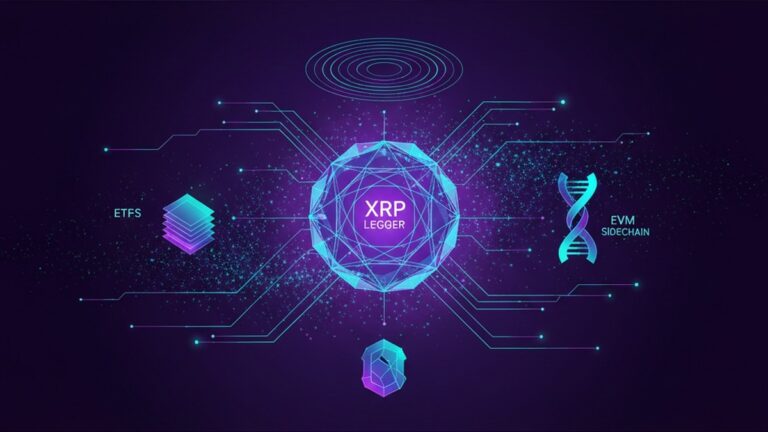The cryptocurrency landscape is no stranger to rapid evolution, and 2025 has marked a significant year for the XRP Ledger (XRPL). Known for its fast transaction speeds and low costs, XRPL is experiencing a renaissance, powered by a confluence of regulatory clarity, innovative technology upgrades, and a surge in institutional interest.
Legal Clarity: A New Dawn for XRP
One of the pivotal factors contributing to XRP Ledger’s recent success is the much-awaited legal clarity surrounding XRP. After years of legal battles and regulatory uncertainty, the United States Securities and Exchange Commission (SEC) finally issued a clear stance on XRP earlier this year, determining that it is not a security. This decision has unshackled XRP from its legal limbo, instilling confidence among investors and paving the way for broader adoption.
This newfound regulatory clarity has not only boosted investor confidence but also attracted a wave of institutional investment. Financial giants, who were previously hesitant, are now exploring XRP for its potential in cross-border payments. This shift is underscored by the launch of several XRP-based Exchange Traded Funds (ETFs) across major financial markets, providing a familiar vehicle for institutional investors to engage with the cryptocurrency.
ETFs: Bridging Traditional and Digital Finance
The introduction of XRP-based ETFs marks a critical juncture in the fusion of traditional finance with the digital asset ecosystem. ETFs have long been a staple in traditional investment portfolios due to their liquidity and ease of access. By bridging the gap between conventional financial products and the burgeoning cryptocurrency market, XRP ETFs are bringing in a new wave of investors eager to tap into the potential of digital assets.
These ETFs aren’t just attracting institutional money; they’re also making it easier for retail investors to gain exposure to XRP without the complexities of managing a digital wallet. This democratization of access is expected to fuel further growth and adoption, making XRP a more mainstream asset.
EVM Sidechain: A Technological Leap
In addition to legal and financial advancements, the XRP Ledger has taken a technological leap with the launch of its Ethereum Virtual Machine (EVM) sidechain. This upgrade is a game-changer, allowing developers to deploy Ethereum-compatible smart contracts on the XRP Ledger. By bridging the gap between two of the most important blockchain ecosystems, the EVM sidechain opens up a realm of possibilities.
Developers can now leverage the XRPL’s speed and cost-effectiveness while maintaining the flexibility of Ethereum’s smart contract capabilities. This compatibility is attracting a new cohort of developers who are eager to build decentralized applications (dApps) on a platform that offers the best of both worlds. From decentralized finance (DeFi) applications to non-fungible tokens (NFTs), the EVM sidechain is catalyzing innovation within the XRP ecosystem.
Global Events: A Catalyst for Growth
2025 has also been a year of significant global events that have further propelled the XRP Ledger’s trajectory. From economic shifts to geopolitical developments, the world is increasingly looking towards blockchain solutions for resilience and efficiency. XRP’s robust infrastructure and established reputation have positioned it as a reliable choice in times of uncertainty.
Moreover, international collaborations have been key in XRPL’s global expansion. Strategic partnerships with financial institutions and technology firms worldwide have bolstered its presence and credibility. As countries explore central bank digital currencies (CBDCs) and blockchain-based remittance solutions, XRP’s cross-border payment capabilities are becoming more relevant than ever.
Balancing Expectations: Challenges and Opportunities
While the outlook for XRP Ledger is undeniably promising, it’s important to acknowledge the challenges that lie ahead. The cryptocurrency market is notoriously volatile, and regulatory landscapes can shift rapidly. Ensuring continued compliance with international regulations will be crucial for sustained growth.
Additionally, as the ecosystem expands, maintaining network security and preventing congestion will be vital. The introduction of the EVM sidechain, while innovative, requires careful management to ensure seamless integration and avoid potential vulnerabilities.
Despite these challenges, the opportunities are vast. As the world becomes more interconnected, the demand for efficient, cross-border payment solutions is set to rise. XRP Ledger’s blend of regulatory clarity, technological innovation, and global collaboration positions it as a frontrunner in the next wave of blockchain adoption.
In conclusion, 2025 is shaping up to be a landmark year for the XRP Ledger. With legal clarity providing a solid foundation, ETFs bridging the gap between traditional and digital finance, and technological upgrades like the EVM sidechain driving innovation, XRPL is well on its way to cementing its place in the future of finance. As the global landscape continues to evolve, XRP’s adaptability and resilience could very well make it a pillar of the blockchain industry for years to come.

Steve Gregory is a lawyer in the United States who specializes in licensing for cryptocurrency companies and products. Steve began his career as an attorney in 2015 but made the switch to working in cryptocurrency full time shortly after joining the original team at Gemini Trust Company, an early cryptocurrency exchange based in New York City. Steve then joined CEX.io and was able to launch their regulated US-based cryptocurrency. Steve then went on to become the CEO at currency.com when he ran for four years and was able to lead currency.com to being fully acquired in 2025.


